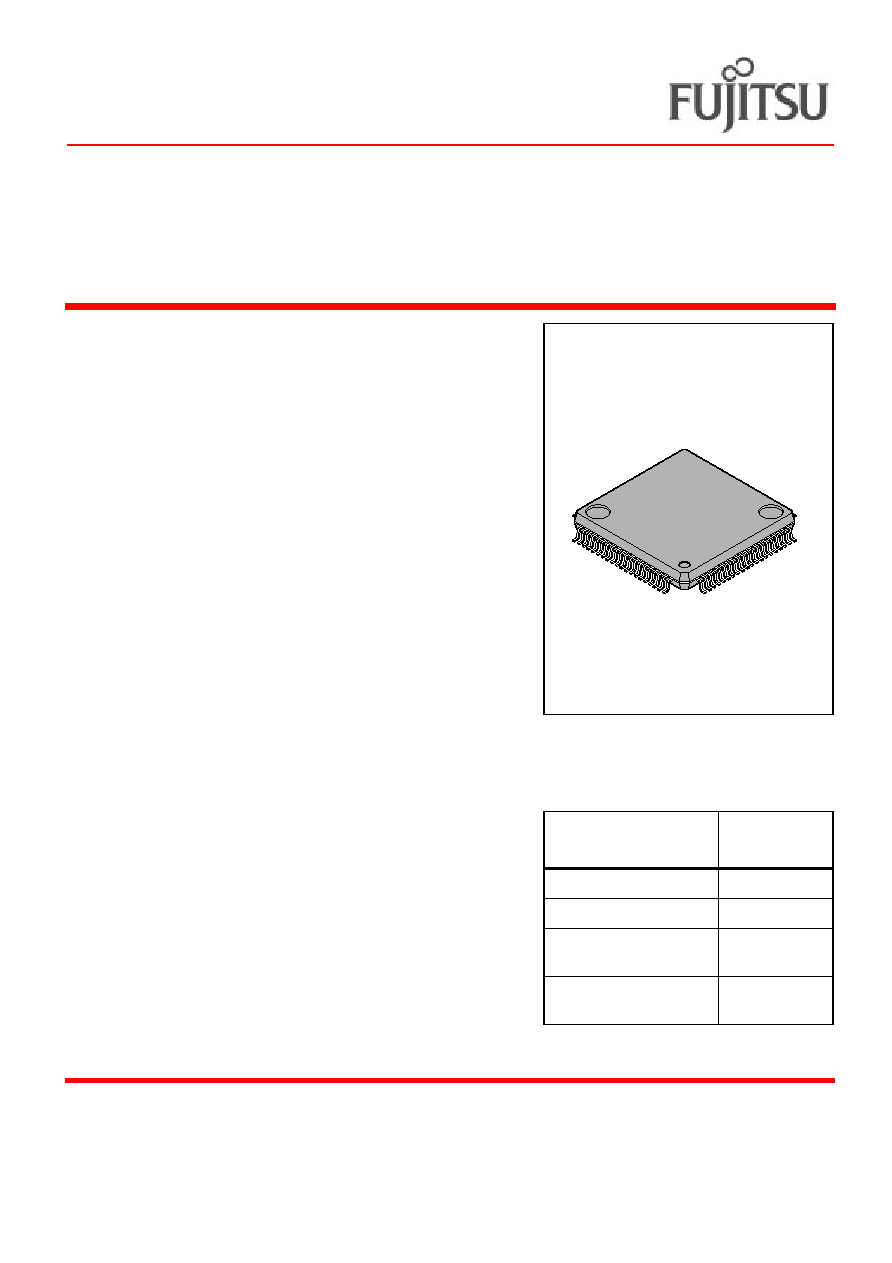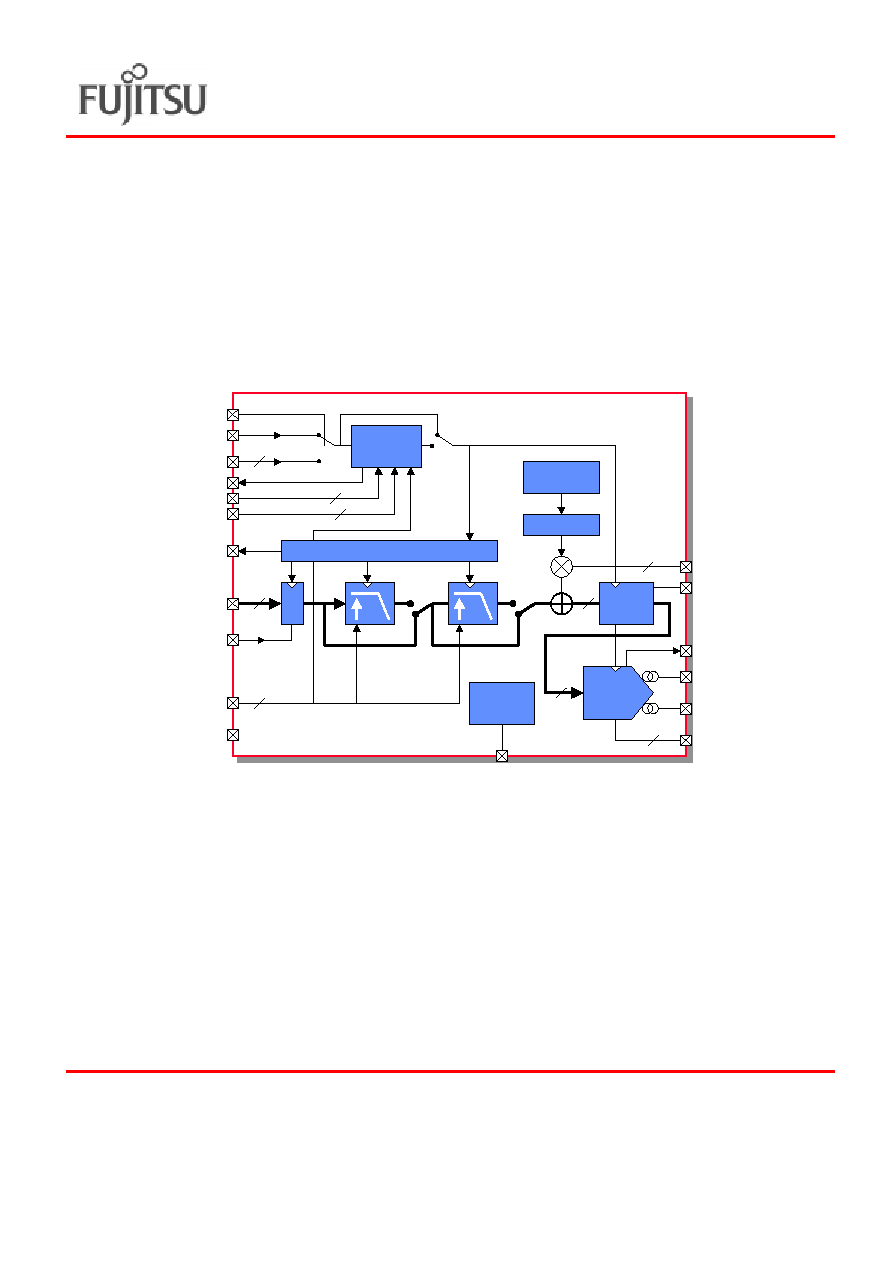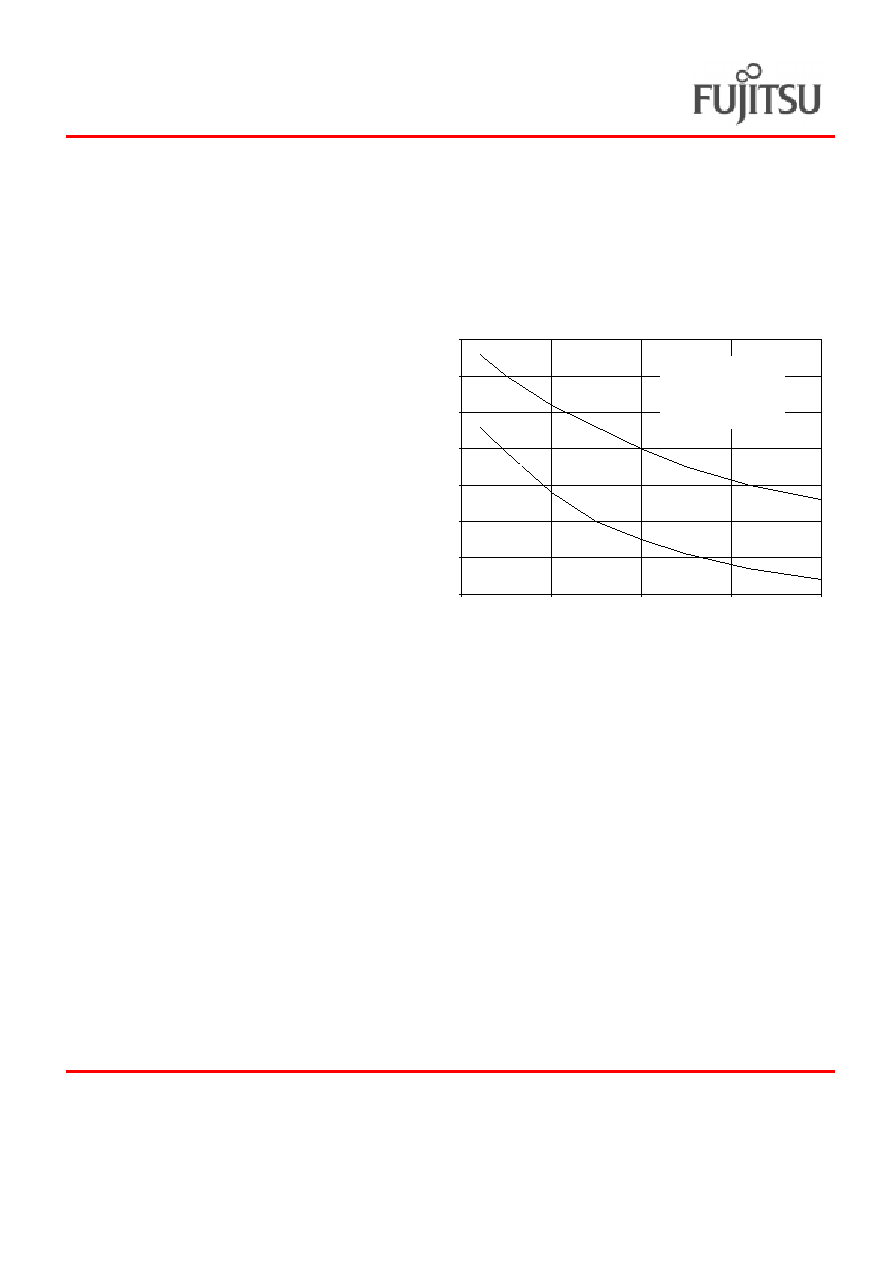 | –≠–ª–µ–∫—Ç—Ä–æ–Ω–Ω—ã–π –∫–æ–º–ø–æ–Ω–µ–Ω—Ç: DK86060-3 | –°–∫–∞—á–∞—Ç—å:  PDF PDF  ZIP ZIP |

Product Flyer
June 2000
MB86060
Version 1.2
16-Bit Interpolating Digital to Analog Converter
FME/MS/SFDAC1/FL_1/4270
This product has Patents applied for in the US and elsewhere including GB2333191A, EP0935345A, JP11-274934A, GB2333171A, EP0930717A, JP11-274935A,
GB2333190A, EP0929158A, JP11-243339A, GB2335097A, EP0940923A, JP11-317667A, GB2335076A, EP0940852A, JP11-251530A.
Copyright © 2000 Fujitsu Microelectronics Europe GmbH
Page 1 of 6
The Fujitsu MB86060 is a high performance 12-bit, 400MSa/s
Digital to Analog Converter (DAC) enhanced with a 16-bit
interpolation filtering front-end. Use of novel techniques for the
converter architecture delivers high speed operation consistent
with BiCMOS or bipolar devices but at the low power of CMOS.
Fujitsu's proprietary architecture is the subject of several patent
applications. Additional versatility is provided by selectable input
interpolation filters, programmable dither and noise shaping
facilities. Excellent SFDR performance coupled with high speed
conversion rate and low power make this device particularly
suitable for high performance communication systems, in
particular direct IF synthesis applications.
Features
∑
16-bit Interpolating Digital to Analog conversion
∑
x1, x2 or x4 interpolation filtering
∑
100MSa/s input, with x4 interpolation enabled
∑
Programmable highpass filtered dither
∑
Selectable 2nd order noise shaping
∑
Versatile CMOS digital interface
∑
Internal programmable clock multiplier
∑
Low power, 3.3V operation (343mW @32MSa/s input, x4)
∑
Performance enhanced pinout with on-chip decoupling
∑
0.35µm CMOS technology with Triple Well
∑
Industrial temperature range (-40∞C to +85∞C)
Applications
∑
Direct IF Synthesis
∑
Cellular basestations
∑
Wide-band communications systems
Ordering Information
Part
Order
Number
MB86060 Datasheet
Contact Sales
MB86060 DAC
MB86060PFV
MB86060 Development
Kit
DK86060-3
MB86060 Development
Kit User Manual
Contact Sales
(FPT-80P-M05)
PLASTIC PACKAGE
LQFP-80

June 2000
Version 1.2
FME/MS/SFDAC1/FL_1/4270
MB86060 16-Bit Interpolating Digital to Analog Converter
Page 2 of 6
Copyright © 2000 Fujitsu Microelectronics Europe GmbH
Functional Description
The MB86060 integrates a 12-bit 400MSa/s DAC with selectable front end processing to provide input
interpolation filtering, dither and noise shaping. Versatile interfacing via the 16-bit parallel CMOS data input
allows different system requirements to be accommodated, with either offset binary or 2's complement data
formats selected by an input format control.
The device is manufactured in a 0.35µm advanced CMOS process with Triple Well extension giving
improved isolation between analog blocks and digital-analog.
MB86060 Functional Block Diagram
Converter Architecture
The MB86060 Interpolating DAC incorporates a number of novel design aspects that are subject to patent
applications. Key to its operation are the current sources where segmented, common centroid, interleaved
techniques for the most significant bits, as well as load matching ensure good linearity and low distortion
to at least the 12-bit level. In the switch elements tracking capacitance is minimised to improve settling,
while controlled rise and fall times improve SFDR performance. Finally the digital decoding uses a 3-
dimensional addressing approach to minimise propagation delays from latch to element.
FML Mixed Signal
DAC
g
Dither
Generator
Clock
Multiplier
12
16
Data In
CLK in (diff.)
DAC
Output
Dither
Reset
Noise
Shaper
x2
Bandgap
Reference
Filter control
NS Enable
x2
HP Filter
Mult mode
3
2
3
Data CLK out
(diff.)
Data Format
Lock
[x2 slow]
[x2 fast]
16
Delay line ctrl
2
Crystal
Shuffle
Control
2
Clk Select
Over
Clock Divider
2
Programmable
Dithermay be
excluded from
final MP
devices

June 2000
Version 1.2
FME/MS/SFDAC1/FL_1/4270
MB86060 16-Bit Interpolating Digital to Analog Converter
Copyright © 2000 Fujitsu Microelectronics Europe GmbH
Page 3 of 6
Segment Shuffling
The DAC core incorporates a proprietary segment shuffling capability which is provided to further improve
linearity, and hence improve SFDR. This feature reduces any signal level dependent effects on linearity as
the same code can be generated by the same number of MSB cells but taken from any quarter of the MSB
segments. Segment shuffling can be selected to operate every 4, 8 or 16 updates of the DAC output using
a random shuffle sequence between the four segments. Most performance improvement will be observed
when the device is used in one of the interpolating modes. The effect of segment shuffling is to produce a
spread noise spectrum, raising the overall noise
floor, but reducing the distortion. For minimum
distortion when generating low frequency
signals, it is recommended that the shuffling
clock rate is no more than 25MHz (DAC Rate /
Segment Shuffling setting). However, low
shuffle clock rates give reduced spreading out of
distortion components.
Noise Shaping
Second order noise shaping can be applied to
interpolated data prior to being passed to the
DAC core. When enabled this provides an
additional reduction in quantisation noise to that
gained through the use of interpolation filtering.
For the x4 interpolation mode this improvement
will be 16dB, equivalent to 2.7 bits.
Clock
The MB86060 incorporates a clock multiplier to generate the required internal x1, x2 and x4 clock signals
from an external reference. The clock multiplier is based on a delay-lock-loop whose delay is adjusted by
a charge pump controlled by a phase detector. A `Lock' indicator is provided so that the system can monitor
the multiplier's condition. For systems where a high frequency clock is available, or the lowest possible jitter
is required, then the clock multiplier may be disabled and the external clock used directly.
Interpolating Filters
The integration of interpolating filters provides a number of benefits to the system implementation. In
general, improved performance can be gained by using a higher DAC conversion rate effectively providing
a higher level of oversampling from the generated signal. For the designer, the problem with this approach
is generating the required high speed digital data, especially when considering high performance wide-
band designs with up to 50MHz of signal. Integrating this processing on-chip with the DAC alleviates this
problem.
60
65
70
75
80
85
90
95
0
10
20
30
40
Generated Frequency
(MHz)
SFDR
(dBc)
50MSa/s Input Data Rate
x4 Mode, 200MSa/s DAC Rate
Noise Shaper On, Dither Off
Amplitude = -1dBFS
Shuffle On
Shuffle Off
Single Tone SFDR Performance

June 2000
Version 1.2
FME/MS/SFDAC1/FL_1/4270
MB86060 16-Bit Interpolating Digital to Analog Converter
Page 4 of 6
Copyright © 2000 Fujitsu Microelectronics Europe GmbH
Other benefits include a reduced effect due to the sinx/x roll-off due to the DAC sample and hold output
stage, which for a conventional DAC represents -4dB at Nyquist, compared to only -0.22dB when operating
in the x4 interpolating mode. Also the digital interpolation filters sharp cutoff and effective stop-band
attentuation improves both in and out-of-band SFDR. This is illustrated below.
The MB86060 features four interpolation filter modes x1, x2(slow), x2(fast) and x4. Mode x1 is as per a
conventional DAC, and choosing between the remaining three modes would depend on the system
requirements. Mode x2(slow) may be advantageous to a system requiring the benefits of interpolation
filtering but saving some power by not running the DAC core at full rate. Mode x2(fast) gives access to the
wider band, slower roll-off interpolation filter allowing wider band signals to be generated compared to the
other modes, for example 74MHz (-0.1dB) for 200MSa/s data rate. Mode x4 for the complete interpolation
filter operation.
-4dB
-13dB
-18dB
-0.22dB
Sinx
x
Sinx
x
x1
mode
-0.9dB
-13dB
Sinx
x
-0.9dB
Sinx
x
0 100 200 300 400 500 MHz
F
DAT
F
DAC
x4
mode
X2 (slow)
mode
X2 (fast)
mode
0 100 200 300 400 500 MHz
F
DAT
F
DAC
0 100 200 300 400 500 MHz
F
DAT
F
DAC
0 100 200 300 400 500 MHz
F
DAT
& F
DAC
Filter Pass Band = 0.43.F
DAT
(-0.1dB)
Filter Pass Band = 0.37.F
DAT
(-0.1dB)
Filter Pass Band = 0.43.F
DAT
(-0.1dB)

June 2000
Version 1.2
FME/MS/SFDAC1/FL_1/4270
MB86060 16-Bit Interpolating Digital to Analog Converter
Copyright © 2000 Fujitsu Microelectronics Europe GmbH
Page 5 of 6
Interpolation Filter Response
Pass Band 0.43fs (-0.1dB)
Stop Band -75dBFS from 0.59Fs -
(Excluding transition band image around 1.5Fs)
[Frequency axis normalised to input data rate]
[Simulated overall x 4 Interpolation filter response]
Programmable Dither
Dither can be added to improve low-level performance and reduce effects due to nonlinearities within the
DAC, and reducing DNL and glitch energy. The dither has programmable amplitude, and is high pass
filtered to fall out of the pass band.
For dither to be used effectively both amplitude and frequency characteristics must be carefully considered.
Obviously the dither amplitude should be larger than the nonlinearities to be masked, but levels significantly
larger than this will ultimately limit available dynamic range for the wanted signal. Similar considerations
should be made for the frequency characteristics, which in the MB86060 the dither is highpass filtered such
that the majority of the energy is concentrated at Nyquist of the DAC output rate.
Development Kit
A development kit, reference DK86060, is available for the MB86060 16-bit Interpolating DAC. The kit
includes an evaluation board that enables simple and effective evaluation of the device.
The board provides a complete evaluation environment for the DAC. A transformer coupled differential
output interface is provided to simplify integration into
target applications and development environments. An
RF clock source can be connected via the transformer
coupled input, and 16-bit data via a 40-way IDC header.
The development kit includes,
∑
Evaluation board with MB86060 device fitted
∑
Spare MB86060 for customer development
∑
User Manual
0
0.2
0.4
0.6
0.8
1.0
1.2
1.4 1.6
1.8
2.0
-120
-100
-80
-60
-40
-20
0
20
Frequency
dB
Combined Filter Characteristics




